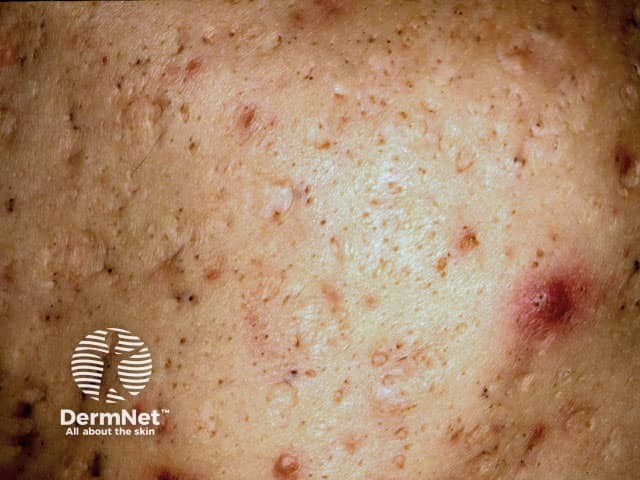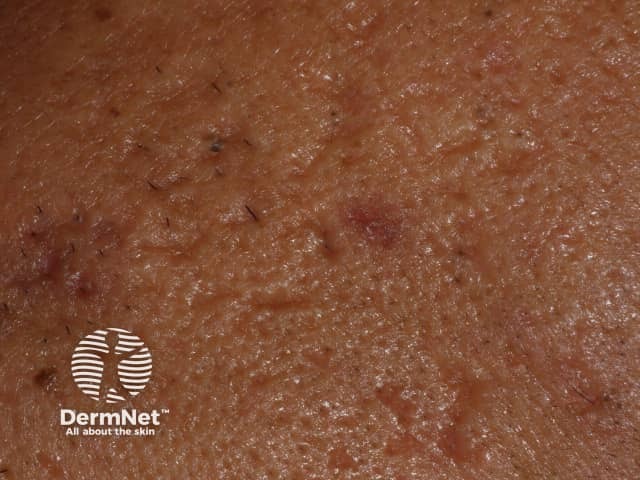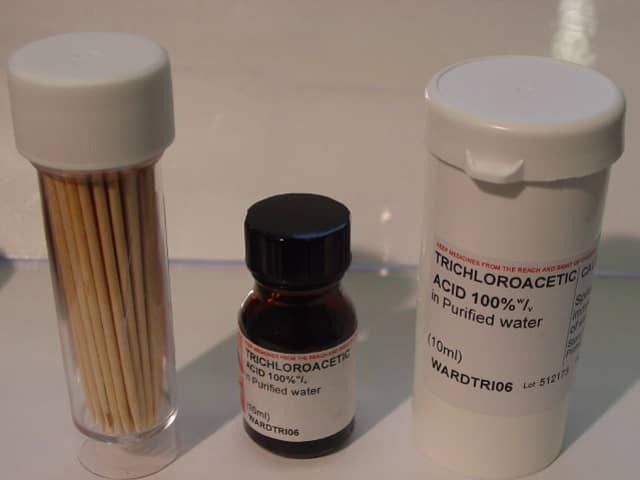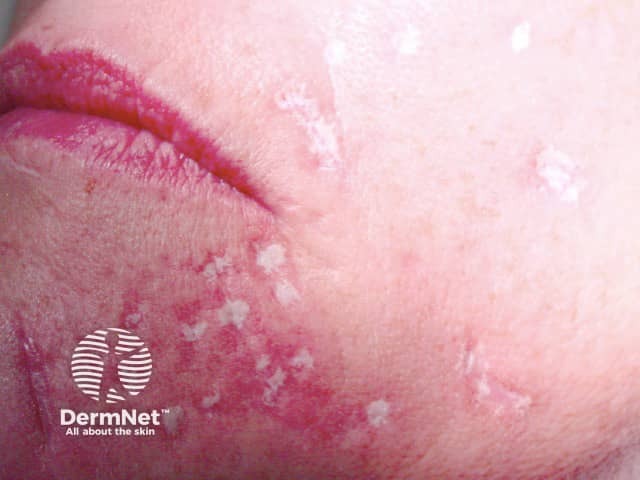Main menu
Common skin conditions

NEWS
Join DermNet PRO
Read more
Quick links
TCA CROSS — extra information
TCA CROSS
Author: Dr Ian Logan, Dermatology Specialist Registrar, Hammersmith Hospital, London, United Kingdom. November 2015. Updated by Dr Ebtisam Elghblawi, Dermatologist, Tripoli, Libya. DermNet Editor in Chief: A/Prof Amanda Oakley, Dermatologist, Hamilton, New Zealand. October 2018.
Introduction
How it works
Indications
Assessment
Performance
Post-procedure
Complications
Treatments
Outcome
What is TCA?
TCA is an abbreviation for trichloroacetic acid, which is typically used in low concentration (20–35%) for a chemical peel and improves the appearance of facial scars and skin ageing.
What is TCA CROSS and how does it work?
TCA CROSS is the chemical reconstruction of skin scars (CROSS) using trichloroacetic acid (TCA). It is most often used as an outpatient clinic procedure to treat atrophic acne scars. It's inexpensive, safe and efficient, but is not always effective.
Acne is a common inflammatory skin condition and may result in atrophic, hypertrophic or keloid scars. Acne scars can cause significant psychological distress and social impact.
The TCA CROSS procedure involves depositing small amounts of TCA at high concentration (70–100%) onto the surface of the atrophic scar. This causes a local inflammatory reaction leading to the formation of new collagen fibres. The aim is to improve the appearance of the scar by increasing collagen reflectance and reducing shadows cast over scar depressions. Complete resolution is unlikely to be achieved with this treatment method alone.
What are the indications for TCA CROSS?
The decision to perform TCA CROSS depends on:
- The type and severity of acne scarring
- Patient preference and expectations
- Clinician experience and expectations.
TCA CROSS is useful in the following types of atrophic scar:
- Boxcar acne scars
- Rolling acne scars
- Ice-pick acne scars.

Ice-pick scars

Rolling scars
Assessment of acne scars
Acne scar severity can be graded using Goodman and Baron’s qualitative acne scar grading system to allow objective pre and post-treatment comparisons.
1. Macular scars
Macular scars can be erythematous, hyperpigmented (brown) or hypopigmented (pale) flat marks. They do not represent a problem of contour like other scar grades but of colour.
2. Mild atrophic or hypertrophic scars
Mild atrophic (thin) or hypertrophic (thick) scars may not be obvious at social distances of 50 cm or greater and may be covered adequately by makeup or the normal shadow of shaved beard hair in men or normal body hair if extrafacial.
3. Moderate atrophic or hypertrophic scars
Moderate atrophic or hypertrophic scarring is obvious at social distances of 50 cm or greater and is not covered easily by makeup or the normal shadow of shaved beard hair in men or body hair if extrafacial, but is still able to be flattened by manual stretching of the skin (if atrophic).
4. Severe atrophic or hypertrophic scars
Severe atrophic or hypertrophic scarring is evident at social distances greater than 50 cm and is not covered easily by makeup or the normal shadow of shaved beard hair in men or body hair if extrafacial and is not able to be flattened by manual stretching of the skin.
How is TCA CROSS performed?
TCA CROSS is technically straightforward to perform and can be undertaken in a matter of minutes, depending on the number of scars to be treated. It is generally repeated on several occasions at 2 to 4-week intervals.
- The patient should be in a comfortable semi-recumbent position and remain still during the procedure.
- The skin is cleansed with chlorhexidine/saline-soaked gauze.
- A fine blunt end-point instrument (such as a tooth-pick) is dipped into TCA and the excess is removed.
- TCA is focally applied to the base of the atrophic scar.
- The instrument is removed at the start of frosting of the skin surface (usually within 10 seconds).
- The procedure is repeated for appropriate remaining scars.
- The skin is intermittently cleansed using saline/chlorhexidine soaked gauze.
Great care should be taken to avoid sensitive surfaces (eyes, mucosal surfaces). Eye covers may be used. Emergency eye irrigation equipment should be at hand. Avoid treatment of patients within 12 months of receiving systemic retinoid therapy due to the risk of healing complications.

Trichloracetic acid for TCA CROSS procedures

Applying trichloracetic acid for TCA CROSS procedures

Frosting after applying trichloracetic acid in TCA CROSS procedure
After the procedure
The patient should be advised:
- Frosting of the scar surface will last up to 12 hours
- The skin around the treated sites will be red and sore for 24 to 48 hours
- After 2 to 3 days a small scab will develop, which falls off after 3 to 7 days
- He or she may wash as normal and may apply make-up if desired
- Sunscreen is recommended to reduce the chance of pigmentation.
Most patients require 3 to 6 treatments with TCA CROSS for optimum improvement. Treatments may be repeated at 2 to 8 week intervals over 6 months.
Complications of TCA CROSS
TCA CROSS is generally well tolerated. Complications are rare when treatment is undertaken by an expert. They may include:
- Prolonged local irritation and erythema
- Damage to mucosal surfaces, ie lip, nostril, conjunctiva or cornea (eye) leading to painful ulceration and potential scarring, if TCA is inadvertently deposited on these sites
- Post-inflammatory hyperpigmentation (usually transient) or hypopigmentation (this may be permanent)
- Coalescence of adjacent scars to form larger scars
- Sub-optimal response or lack of improvement in scarring.
Treatments combined with TCA CROSS
Treatments that can be combined with TCA CROSS for acne scars include:
- Topical retinoids
- Microneedling — Dermaroller, Dermapen
- Fractional laser treatment
- Subcision.
Combination treatments may result in good outcomes with few complications.
What is the outcome following TCA CROSS?
When used correctly, TCA CROSS is moderately effective for atrophic acne scars. Patients may expect a 1 to 2-grade improvement in their acne scars over a 6-month period.
Greater levels of patient satisfaction are associated with more severe pre-treatment scarring.
References
- Lee JB, Chung WG, Kwahck H, Lee KH. Focal treatment of acne scars with trichloroacetic acid: chemical reconstruction of skin scars method. Dermatol Surg 2002;28:1017–21. PubMed
- Goodman G. Commentary: Subcision versus 100% Trichloroacetic Acid in the treatment of Rolling Acne scars. Dermatol Surg May 2011; 37(5):634–636. PubMed
- Bhardwaj D, Khunger N. An assessment of the efficacy and safety of CROSS technique with 100% TCA in the management of Ice-pick acne scars. J Cutan Aesthetic Surg. 2010 May-Aug; 3(2); 93–6. PubMed
- Agarwal N, Gupta L, Khare A et al. Therapeutic response of 70% Trichloroacetic acid CROSS in atrophic acne scars. Dermatol Surg May 2015; 41(5):597–604. PubMed
- Arsiwala SZ. Subcision with CROSS TCA peels for moderate to severe acne scars. Indian Dermatol Online J. 2014 Jan;5(1):97-8. doi: 10.4103/2229-5178.126055. PubMed PMID: 24616874; PubMed Central PMCID: PMC3937507.
